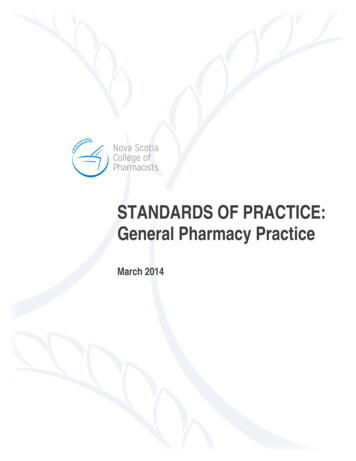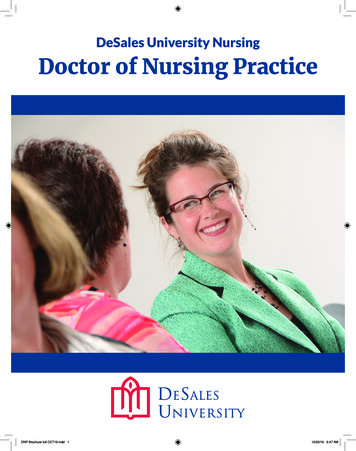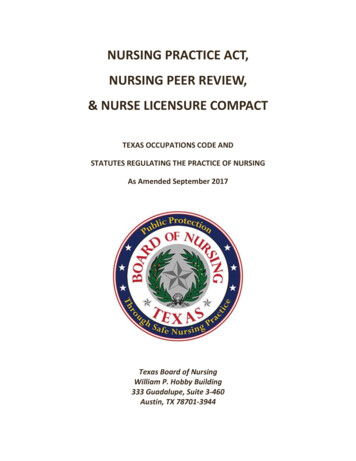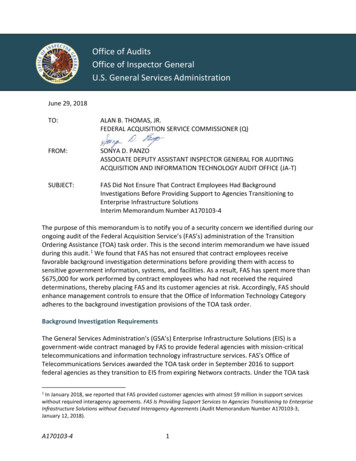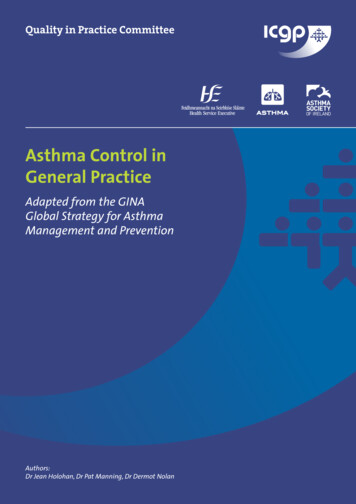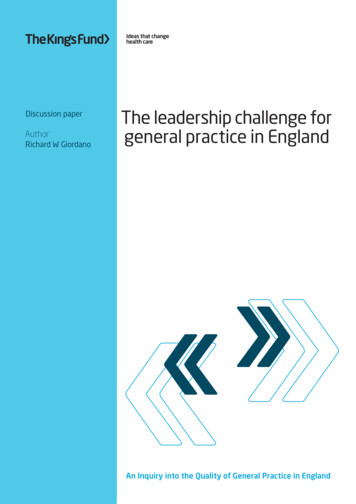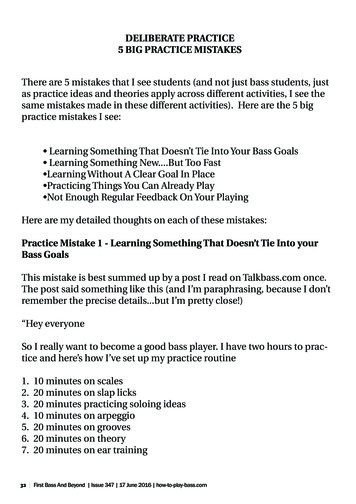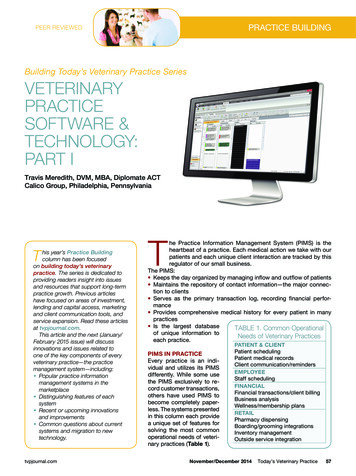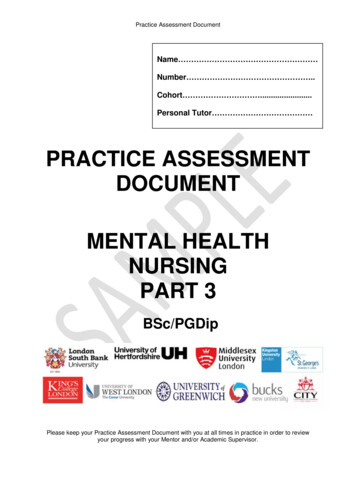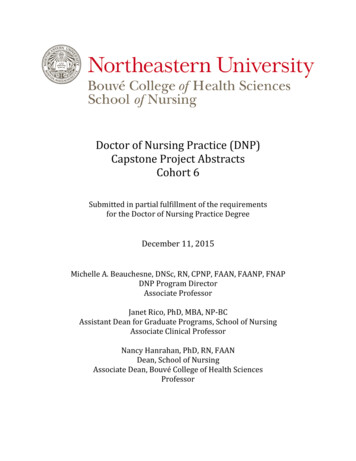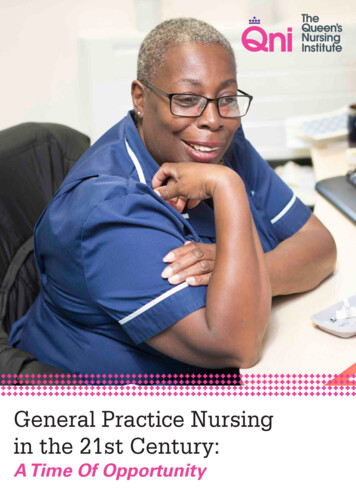
Transcription
General Practice Nursingin the 21st Century:A Time Of Opportunity1GPN 21st Century Report
Contents1.Chief Executive’s Introduction32.Why this survey?53.Headline findings54.Background65.FindingsWorkforce ProfileEmploying organisationMultiple jobsPay bandIncrements based on performanceSalaryHours of workWorking evenings and weekendsAnnual leaveIndemnity coverJob TitleLine managementAnnual appraisalsNMC revalidationQualificationsProfessional developmentEntry to and preparation for GP NursingGeneral Practice Nursing as a careerRoles and responsibilitiesHome visitingAdditional areas of responsibilityWorkload pressuresMultidisciplinary workingGeneral Practice Nurse skillsGPN and District Nurse 6.Conclusion337. Required actions348. References35Edited by Matthew Bradby and Chloe McCallumCopyright: The Queen’s Nursing Institute 20152GPN 21st Century Report
‘General Practice Nurses have something important to say and theywish their stories to be heard.’1.Chief’s Executive’s IntroductionWhen The Queen’s Nursing Institute embarked on anational survey of General Practice Nurses (GPNs),the aim was to reach at least 1000 nurses working inprimary care around the UK.The survey was required to provide the QNI withrobust evidence to support our ongoing campaign forexcellence in nursing in the community and primarycare - rather than relying on anecdotes from practice- albeit that these stories gave a consistent messageabout the challenges and opportunities faced byGPNs.Within a week of the survey opening we had exceededour target response and by the time the survey closedsome ten weeks later, we had responses from 3,405nurses, representing approximately 15% of theentire GPN workforce in the UK. The large numberof comprehensive responses tells a story in itself:General Practice Nurses have something importantto say and they wish their voices to be heard.Furthermore, they trusted the QNI with their storiesand to provide a considered analysis of the hugeamount of data we were given. My thanks to allthose who took the time to complete the survey,to tell us about the joys of working as a nurse ingeneral practice and also the challenges. Aboveall, theirs is a story of opportunity: the opportunityto work as highly skilled, autonomous practitionersand to serve a local community – but also theunrealised opportunity for a higher profile and a morecomprehensive, supported role in meeting the needsof the registered population.Arguably, there has never been a better time ofopportunity for nurses working in general practice,3GPN 21st Century Reportwith a current focus on policies to transform primarycare and provide an increasing range of servicesbased on the needs of the local community registeredwith the General Practitioner service (Primary CareWorkforce Commission, 2015; NHS England, 2014).General Practice Nurses have the potential tocontribute significantly to the transformation agendaand to offer a comprehensive and supportive nursingservice to their patients which focuses on healthpromotion and supported self-care.Following an exploration of the findings, the reportconcludes with a call to action to address theissues raised, which require an urgent response.We anticipate that action will be needed locally,regionally and nationally to address the issues wehave identified - at the level of employer through tothe national statutory bodies, which form part of thestructure of our NHS.The QNI will be responding to the findings too. In2016, we will publish our online resource: ‘Transitionto General Practice Nursing’, to support nurses whoare new to the role. Following our launch with QNIScotland (QNIS) of new voluntary standards forDistrict Nurse Education and Practice (QNI/QNIS,2015), in 2016 we will develop QNI/QNIS voluntarystandards for General Practice Nurse Education andPractice, to enhance the existing NMC standards forspecialist GPN practice.We will also use the findings to support nursesworking in primary care and to campaign for excellentnursing care for individuals, families and carers intheir local communities.Dr Crystal Oldman
Contents4GPN 21st Century Report
‘Nurses in General Practice provide significant levels of interventionand support at every point during a person’s life.’2. Why this survey?In this study, the QNI has sought to create a snapshotof the role of the General Practice Nurse (GPN) in 2015,based on the perspectives of the nurses themselves.The study was inspired by the 2020 Vision reportsthat the QNI published in 2009 and 2014, whichfocused on the work of the District Nurse (DN).Those studies highlighted the particular challengesfacing District Nurses, which have led to specificpolicy responses from the QNI and other healthcareorganisations, which are still ongoing. We thereforewished to replicate this work to highlight the uniquechallenges facing General Practice Nurses, who workin a very different setting to those in the DN serviceand whose employment structure is completelyunlike that of their DN colleagues. As most GPNswork in small teams, employed by small independentorganisations, they are subject to an extremely widevariety of terms and conditions, educational anddevelopment opportunities and career structures.This survey illustrates and celebrates that variety,but also indicates that standardisation in some areaswould be welcome. By gathering and publishinginformation about the profession, it is hoped that thiswill enable policy makers, employers, and nursesthemselves to be better equipped to deal withcurrent and future challenges and to embrace newopportunities as they arise.It is clear from the survey that many enter theGeneral Practice Nursing service because of theflexibility that it offers, combined with the challenge,variety, opportunity and inherent value of the nursingwork that can be offered in general practice. It is vitalto ensure that these elements that make GeneralPractice Nursing work appealing are maintainedand developed, in order that nurses continue to beattracted into the service and good staff retained,continuing to develop their skills and knowledgewhile in the role.The report is designed to inform the work takingplace on the future direction of primary care and thedevelopment of new service models. It provides aclear description of the current state of the GeneralPractice Nurse workforce from the perspective ofthe nurses working in GP practices – and reveals thatnurses can be at the centre of future service models5GPN 21st Century Reportin primary care, providing high quality, competentcare for their local communities. The headline findingsare summarised below.3. Headline findingsPatientsThis survey validates the role of the General PracticeNurse and the significant levels of intervention andsupport provided by nurses in General Practice atevery point in time during a person’s life, from infancy,childhood, adolescence and adulthood, to middle andolder age.Workforce 33.4% of General Practice Nurses are due toretire by 2020Men are under-represented, comprising only2.0% of the General Practice Nurse workforce43.1% did not feel their nursing team has theright number of appropriately qualified and trainedstaff to meet the needs of patientsAt the time of the survey 78.8% had consideredpreparation for NMC re-validationEducation 53.0% reported that their employer alwayssupports their professional development10.6% hold an NMC recordable specialist practicequalification in General Practice Nursing32.6% of General Practice Nurses areindependent prescribersJust 27.0% of the employers offered placementsfor pre-registration nursing students, comparedto 61.5% offering placements to medical studentsEmployment 22.8% of nurses working in General Practicehave two jobs32.6% of General Practice Nurses reportedworking evening sessions (after 6pm) and 18.5%work weekendsOver 38.3% indicated that they undertook visitsto patients at homeOnly 35% felt that their salary reflected their rolewithin the practiceSalary and other terms and conditions such asannual leave entitlement vary widely
Contents4. BackgroundThe Queen’s Nursing InstituteThe QNI was established in 1887 to train DistrictNurses, but from the 1970s the remit of the charityhas broadened to provide a wide range of supportto all community nurses, including General PracticeNurses.The title of Queen’s Nurse (QN) was reintroduced bythe charity in 2006 and General Practice Nurses areeligible to apply for the QN title.As the focus of care delivery moves to primarycare, and disease prevention and treatment inthe community, it is envisaged that more nurseswill move from secondary care to the diversityof community settings. In order for them to makethis transition effectively, the QNI is dedicated toproviding knowledge resources and other forms ofsupport.The QNI is currently in the process of publishing anew online resource, ‘Transition to General PracticeNursing’ which will serve as an introduction to themain themes of working in this setting. The resourceis based on already published resources for DistrictNurses and those entering School Nursing.Previous GPN surveysThe QNI has not previously carried out a survey ofGeneral Practice Nurses. Our findings build on recentsurveys from the Royal College of Nursing (RCN,2010) and the Royal College of General Practitioners(RCGP, 2014), whilst providing a broader, currentpicture of General Practice Nursing.Survey methodThe QNI used SurveyMonkey to collect responsesfrom 21 April 2015 to 28 June 2015. The survey waspromoted principally via nursing media (printed andonline) and by the QNI’s own networks, includingemail and social media channels. 3405 nursesresponded and respondents had the option to skipquestions. This report presents a detailed analysis ofboth the qualitative and quantitative data that wassupplied by respondents.Percentage values given below refer to the number6GPN 21st Century Reportof nurses as a proportion of respondents to thatquestion, or as a proportion of the total number ofrespondents where stated.4. FindingsThe QNI operates in England, Wales and NorthernIreland. Our sister charity, QNI Scotland, is based inEdinburgh and operates exclusively in Scotland. Itwas not practicable to limit the survey to particularparts of the UK; however nurses were asked in whatregion of the UK they work, which showed a broadgeographical spread of all regions.In terms of country distribution, the respondents arelocated as follows:CountryEnglandWalesNorthern IrelandNumber of GPNs303224672Scotland76Total responses 3426Percentage88.5%7.2%2.1%2.2%This was the first time that the QNI has carried outa survey of nurses in general practice, so it wasnot possible to compare results of this survey to aprevious QNI sample. However, a review of recentsurveys of General Practice Nurses carried out bythe Royal College of Nursing and the Royal Collegeof General Practitioners was made when compilingthis report, to help establish any common themes ortrends that have been reported in recent years.Respondents were asked for the size of the registeredpopulation that their practice covers.Registered ListNumber ofGPNsUnder 0220,000 144Skipped question 577Percentage15.7%38.1%30.5%10.7%5.1%
‘23.1% of survey respondents have more than one job.’Workforce profileAlmost 98% of respondents were female. Thisrepresents a higher proportion than in other branchesof nursing. The survey did not establish reasons forthis, but further investigation could be carried outwith male nurses to help determine why so few menenter this specialist area of the profession. A largenumber of respondents indicated that childcare andother family circumstances were a major reason whythey entered General Practice, which may help explainthe preponderance of women in the workforce.The majority, some 98.5%, were registered AdultNurses, 1.0% of respondents were registeredChildren’s Nurses, 0.3% were registered MentalHealth Nurses and 0.2% were registered LearningDisability Nurses.Employing organisationThe large majority are employed by GeneralPractitioners, but there is a significant number whowork for a variety of other organisations, and someare self-employed.Employing organisation Number of GPNsGeneral PractitionerLocal Community NursingProviderSocial EnterpriseCommunity InterestCompanyPrivate CompanyClinical CommissioningGroupUniversitySelf-employedMultiple jobs29716623138486296123.1% of survey respondents have more than onejob, which reinforces the flexible nature of this careerpath and confirms the previous finding by the RCN in2009 that 22% of General Practice Nurses have anadditional job. However, this may also indicate thatsome nurses are compelled to hold more than onejob for reasons outside of their control, for example7GPN 21st Century Reportto achieve a high enough salary or to enable them tomanage other commitments.Respondents were able to comment about the natureof their multiple jobs, which revealed the breadthof their individual experiences. Answers includeduniversity lecturer, bank nurse, chiropractor, flightnurse, specialist nurse (e.g. respiratory), midwife,outreach work, nursing home, out of hours nursing,travel clinic, walk in centre, CCG Lead Nurse. Someindicated that they held three different jobs, and onerespondent listed five, writing:‘To balance my family life I work 16 hours a weekas a practice nurse. I also work from home for[the] Open University as a practice tutor for pre-regnursing students 5 hours a week. I have 3 zero hourscontracts as a staff nurse, district nurse and smokingcessation advisor and usually work 3-4 shifts a month.Whilst having 5 jobs sounds excessive it is mucheasier than one district nursing post and much betterfor my stress levels and my family.’Pay BandThere is no agreed pay scale for nurses working ingeneral practice. Respondents were asked whichpay band reflects their salary.Pay Band45678Nurse PartnerPrefer not tosayOther (pleasespecify)Number ofGPNs24453129980136054414Percentage oftotal 1% responded with Band 6, and 23.5% with Band7. This smaller number at Band 7 may reflect thenumber of more senior nurses within practices, whoare in a position of managing teams, or may simplyreflect local variation, experience or other reasons forseniority.
Contents8GPN 21st Century Report
‘My salary compared to that of my peers - who work in secondarycare with the same qualification - is much less.’430 respondents added comments, many of themindicating that they did not know which pay band theywere on, or that their practice did not use pay bands,or that they were paid according to the Whitley Scale(the pay scales agreed by the General Whitley Councilthat preceded Agenda for Change pay scales thatwere introduced in 2004 15/03/afc-pay-scales).Some nurses commented with an hourly rate, ona range between 14.60 and 22 and just 1.6%of respondents answered that they were a NursePartner.Increments based on performanceRespondents were asked if they had incrementsapplied to their salary based on their performance.The large majority, representing 81.5%, respondednegatively. 9.7% responded yes, and the remaindergave qualified answers or in some cases wereunsure. Comments included:‘As far as I understand it, as I become more skilled- and bring in more money for the practice, I willhopefully have some reflection of this in my pay. Ifthis does not happen then I may move on, as at themoment Practice Nurses are difficult to recruit whereI live so the nurse is in a position of strength (foronce).’‘No - within general practice the majority of staff haveto fight and negotiate for ANY form of salary increase/enhancements/increments. GPS are classed asprivate employers and so staff do not benefit fromNHS recruitment / salary initiatives i.e. “Agenda forChange “!’‘No. Whenever I have completed some training thatmeans I gain a new skill I have had to negotiate anincrease in my salary to reflect the new role I amperforming. Other colleagues who are uncomfortabledoing this have had no increase in salary.’‘We do not have an incremented pay scheme atwork and do not know a GP surgery that does. I feelthis would be a worthwhile structure as you can seewhere you are and where you are likely to get to ifyou continue to broaden your practice base skills/specialist areas The surgeries I have worked inhave all compared the current practice nurse salaryto the agenda for change pay spine but have nevertaken on the incremental pay.’Do you think your salary reflects your role?Respondents were able to respond to this questionwith free text. Approximately 35% answered ‘yes’or equivalent. The remainder (65%) either answered‘no’ or gave an equivalent negative response, in somecases emphatically so. Some answers entered intomore detail about their reasoning for their answer.That two thirds of General Practice Nurses believethey are not properly remunerated should be a causeof concern to their employers and to commissionersresponsible for staff retention and workforceplanning.A selection of typical comments is given below:‘We have quite a bit [of] responsibility, within loneworking, chronic disease management and beingencouraged to undergo nurse prescribing, which Ifeel a pay band 5-6 does not reflect.’‘No, I had a pay rise due to handing in my noticeand 2 weeks prior to leaving the partners apologisedand offered me a pay rise in order to stay which Iaccepted. I have worked at the surgery for 4 yearsand this was my only pay rise.’‘My role as clinical nurse manager, I am responsiblefor all clinical areas including infection control, healthand safety, policies with the practice, purchasing,education, invoicing and claims for enhancedservices. Managing all if this gives me a remunerationif 15.98 p/h.’‘No, Practice Nurses are mostly employed by GPswho can pay us what they like. Whilst trying tonegotiate my own pay rise last year (the first for 6years,) I rang round several other local surgeries tofind that Practice Nurses, who are all doing the samejob get very different salaries and remuneration.’‘No. I am the clinical lead nurse. I mentor junior nursesand advise on all aspects of the role to colleagues. Iam paid the equivalent of 15 / hr gross, which I donot feel reflects the degree of responsibility, stress,organisational and department management andorganisational skills that my role entails. I earned9GPN 21st Century Report
Contentsmore in the private sector in a nursing home withoutmy degree and masters level qualifications.’‘No. I think we are taking on more and moreresponsibility. INR clinics, 24 hour blood pressuremonitoring, post-natal checks, increased numberof childhood/teenage immunisation, medicationreviews, annual chronic disease checks, over 75health checks, NHS health checks, smears, injections,phlebotomy etc. to name but a few.’‘Not at all. I am a supplementary and independentprescriber and my salary compared to that of mypeers who work in secondary care with the samequalification is much less. I work very much inisolation and am often the only clinician on thepremises which carries a great deal of autonomy andresponsibility.’are working thirty minutes to an hour more than theircontracted hours each day. Less than one third ofthose who responded report doing no overtime at all.Number ofunpaid hoursworkedNone12345More than 5Skipped questionNumber %20.9%10.9%6.3%4.5%8.5%Working evenings and weekendsHours of workThe number of hours worked shows a very broadspread, with the large majority of nurses workingbetween 16 and 40 hours per week. This datasupports the comments made by respondents (seebelow – why nurses entered general practice) aroundthe importance of flexibility and work-life balance.Number of hoursworkedup to 56 to 1011 to 1516 to 2021 to 2526 to 3031 to 35
surveys from the Royal College of Nursing (RCN, 2010) and the Royal College of General Practitioners (RCGP, 2014), whilst providing a broader, current picture of General Practice Nursing. Survey method The QNI used SurveyMonkey to collect responses from 21 April 2015 to 28 June 2015. The survey was promoted principally via nursing media .
